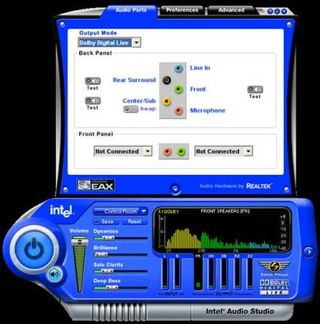Intel's HD Audio PC Sound Ambitions
Is Dolby Digital To Your Liking?
The most exciting element is certainly the Dolby Digital Live mode (whose logo decorates Intel Audio Studio). This is a Dolby Digital 5.1 real-time encoder. In this mode, the S/PDIF digital output delivers an AC-3 signal. The available technical information, available from both Intel and from Dolby is very patchy, and it is hard to get an accurate concept of just what Dolby Digital Live is capable of. Our research shows that - at least on the computer we were using - choosing Dolby Digital Live in the output configuration deactivates the analog outputs and sends an AC-3 (Dolby Digital encoded) signal to the S/PDIF output. This signal is immediately recognized and decoded by an external decoder.

This function is active from any audio source. But it's harder to find out what sort of processing applied to mono or stereo sources will produce an AC-3 (5.1) signal. With Dolby Digital Live, Dolby seems to be trying to create Dolby Digital, the standard and the vector for all audio signals in the home environment, using a PC as the source and decoding the signal on Home Movie Theater or a system of speakers with a decoder. From this point of view, the S/PDIF link clearly has an advantage, since it only requires a single cable. But there are still some questions that remain unanswered, such as how will the link be managed with DVD Audio that deactivates digital output?
If you look and see what is happening with the PC itself when you broadcast a stereo music signal, for instance, you will see that, unlike what happens in a classic configuration, the sound is present in all the active speakers (up to 7.1). So the original is indeed being processed, but in such a way that the user has neither control nor information - and this will not fail to annoy the purists. No one knows what will happen to get 7.1 sound because even Dolby Digital Live had to stop at 5.1! Maybe the levels can be adjusted on the various channels using the Windows editing desk, but nothing is said anywhere about any coding or even decoding.

The Windows editing desk can control all the outputs from a 7.1 system.
So there is still a lot to do before the user is offered control of the process and information about how it is implemented. Naturally, Dolby emphasizes the advantages of its sound processing, stressing that it is universal (all types of Home Movie Theater can use Dolby Digital decoding) and that for games, it provides sound immersion that contributes to their realism. All this still remains to be evaluated once the management tools are available to the user. Let's hope we won't be condemned to the "black box" without either information or control. In this respect, it should be interesting to see how the main players in the PC equipment market (Creative, Hercules and Terratec) will react.
Stay on the Cutting Edge
Join the experts who read Tom's Hardware for the inside track on enthusiast PC tech news — and have for over 25 years. We'll send breaking news and in-depth reviews of CPUs, GPUs, AI, maker hardware and more straight to your inbox.
Current page: Is Dolby Digital To Your Liking?
Prev Page Software, Continued Next Page Test Configuration And Audio MeasurementMost Popular

